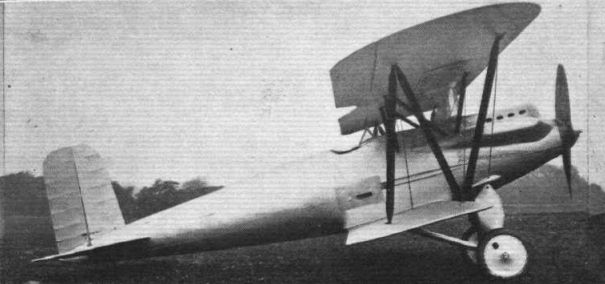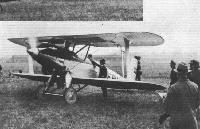
Описание
Страна : Великобритания
Год : 1926
Единственный экземпляр
Одномоторный санитарный и транспортно-пассажирский самолет
Avro серии 566 и серии 567 Avenger
26 июня 1926 года впервые взлетел прототип одноместного истребителя Avro серии 566 Avenger (позднее Avenger Mk I). Он представлял собой цельнодеревянный биплан с очень чистыми аэродинамическими формами. Фюзеляж типа монокок, овального сечения с обшивкой из красного дерева, крылья покрыты полотном. Самолет оснастили 12-цилиндровым безредукторным двигателем Napier Lion VIII.
Несмотря на очень хорошие характеристики, Avenger не вызвал интереса у военных, поэтому его переделали в спортивный самолет Avro серии 567 Avenger Mk II. На нем изменили бипланную коробку: крылья стали одинакового размаха, а для повышения угловой скорости крена элероны установили как на верхнем, так и на нижнем крыле. Кроме того, применили I-образные межкрыльевые стойки, модифицировали шасси и установили более мощный двигатель Napier Lion IX, 553 л.с. (412 кВт). В сентябре 1928 года Avenger Mk II предлагали Румынии в качестве истребителя, но безуспешно. Самолет, добившийся некоторых результатов в авиагонках, в 1931 году разобрали, а фюзеляж стали использовать как учебное пособие.
ТАКТИКО-ТЕХНИЧЕСКИЕ ХАРАКТЕРИСТИКИ
Avro серии 561 Andover
Тип: одномоторный санитарный и транспортно-пассажирский самолет
Силовая установка: V-образный двигатель Rolls-Royce Condor III мощностью 650 л. с. (485 кВт)
Характеристики: максимальная скорость 177 км/ч на оптимальной высоте; скороподъемность 640 м/мин; практический потолок 6705 м
Масса: пустого самолета 1074 кг; максимальная взлетная 1461 кг
Размеры: размах крыла 9,75 м; длина 7,77 м; высота 3,12 м
Вооружение: один неподвижный пулемет калибра 7,7 мм для стрельбы вперед
- Описание
Фотографии
-
Flight 1927-03 / Flight
Регистрационный номер: G-EBND [12] Avro "Avenger" (Napier "Lion" VIII). This single-seater fighter, evolved last year by the same designer of the "Ava," shows the versatility and ability that is expected of the aircraft designer. It has a monocoque fuselage, beautifully streamlined, into which the cylinder blocks are very neatly faired. Its clean lines and slim appearance suggest very obviously its speed and a performance suitable for its purpose. A notable aspect of the design is the tall, almost oblong, rudder and fin, whilst the neat and simple undercarriage is another feature It is fitted with Lamblin wing-type radiators on the top plane.
-
Flight 1926-07 / Flight
Регистрационный номер: G-EBND [12] AVp2: Whether or not the name "Avenger" has anything to do with it is not known. In looking at this machine it is somewhat difficult to realise that it is a single-seater fighter and not a racer, so clean are the lines and so carefully is the equipment tucked away. The Lamblin radiators under the top 'plane should not offer much more head resistance than the wing type of radiator which follows the contour of the wing section. The careful cowling of the special Napier direct-drive "Lion" should be noted. The fuselage is of monocoque construction.
-
Flight 1926-09 / Flight
Регистрационный номер: G-EBND [12] THE AVRO "AVENGER": These four views of the machine show the remarkably clean lines. The rudder, wholly above the tail, somehow gives a German appearance. In the inset Mr. Bert Hinkler "gives scale" to the nose. It should be remembered, however, that Hinkler is one of our smallest pilots in the matter of stature, though certainly not in nerve.
-
Aeroplane Monthly 1982-10 / P.Capon - Capon's Corner
Регистрационный номер: G-EBND [12] The Avro Type 566 Avenger I G-EBND outside the Avro Hamble works. Note the Avro logo on the hangar, top right. This single-seat fighter was powered by a 525 h.p. direct drive Napier Lion VIII engine. It was later rebuilt as the Avro 567 Avenger II and ended its days as an instructional airframe with AST Ltd, also based at Hamble. The photograph was taken in May 1928.
-
Air Enthusiast 1972-11 / Fighter A to Z (18)
Регистрационный номер: G-EBND [12] Of extremely clean design by contemporary standards, the Avro 566 Avenger was eventually modified for racing as the Avro 567 Avenger II.
-
Flight 1928-07 / Flight
Регистрационный номер: G-EBND [12] THE KING'S CUP AIR RACE: Flying-Officer Joseph Summers, on the Avro "Avenger" (Napier "Lion") who started scratch at 11.23 a.m.
-
Air Pictorial 1955-11 / Photos by request
Регистрационный номер: G-EBND [12] AVRO 566 AVENGER. The Avenger was one of the series of prototype single-seat fighter biplanes produced between the two World Wars. It first appeared in 1926, powered by a 525-h.p. Napier Lion VIII engine, which was later substituted by a 570-h.p. Lion XI. With the latter engine the speed was 180 m.p.h., and the rate of climb 2,100 ft/min. The fuselage was a metal monocoque structure, and the design allowed for the fitting of wings of different areas for operation at different heights and in various categories. In this picture the Avenger is seen starting from Hendon in the King's Cup Air Race on 20th July 1928, flown by J. ("Mutt") Summers. Dimensions: span 28 ft. 0 in.; length 25 ft. 6 in. Weight loaded 3,414 lb.
-
Flight 1926-09 / Flight
Регистрационный номер: G-EBND [12] SPEED! Mr. Bert Hinkler gives a demonstration of the performance of the Avro "Avenger" with Napier engine. Figures cannot be given, but the machine is certainly extremely fast.
-
Flight 1926-09 / Flight
Регистрационный номер: G-EBND [12] MANOEUVRABILITY: These views of the Avro "Avenger" in flight, piloted by Bert Hinkler, indicate that controllability is not lacking. The engine is a Napier.
-
Flight 1928-05 / Flight
Регистрационный номер: G-EBND [12] The fast single-seater Avro "Avenger," which tore along the enclosures and then zoomed, piloted by Flt.-Lieut. Luxmoore.
-
Flight 1928-07 / Flight
Регистрационный номер: G-EBND [12] Squadron-Leader J. Noakes applying his crazy flying inventiveness on the Avro "Avenger" at the Air Pageant, Blackpool.
-
Flight 1928-07 / Flight
Регистрационный номер: G-EBND [12] FASTEST, IF NOT FIRST: Flying-Officer Joseph Summers, who won the special prize of ?100 (presented by Mr. Alan S. Butler) for the fastest time over the course. Piloting the Avro "Avenger" (Napier "Lion") he averaged 149 m.p.h.
-
Мировая Авиация 39
Avro Type 566 Avenger
- Фотографии













